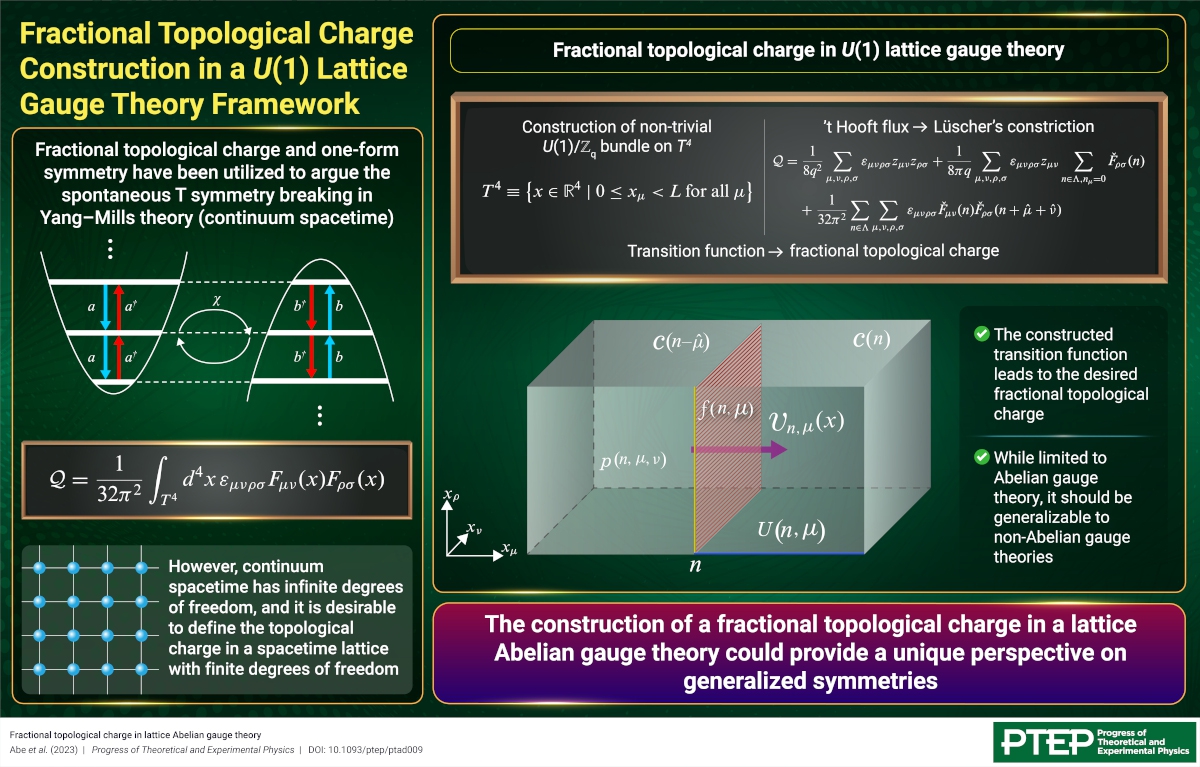Fractional Topological Charge Construction in a U(1) Lattice Gauge Theory Framework
© The Physical Society of Japan
This article is on
Fractional topological charge in lattice Abelian gauge theory
(PTEP Editors' Choice)
Prog. Theor. Exp. Phys. 2023, 023B03 (2023).
We have constructed a fractional topological charge in the lattice Abelian gauge theory formalism, which avoids the issue of infinite degrees of freedom in continuum spacetime quantum field theory.

The invariance of certain features of a dynamical system under continuous or discrete transformations is a fundamental concept in physics called symmetry. Symmetry is extremely useful for studying systems in fields ranging from high energy particle physics to condensed matter physics. Given its importance, the concept has been generalized to higher forms (one-form, two-form, etc.) and non-invertible symmetries.
One particular example of the application of such generalized symmetries comes from the spontaneous breaking of time-reversal (T) symmetry in Yang-Mills theory, which uses the one-form symmetry and the anomaly associated with it. Notably, this anomaly arises from a fractional topological charge emerging from a two-form gauge field.
Such a fractional topological charge has been formulated in continuum quantum field theory. However, the formulation remains rather formal since quantum field theory, considered in continuum spacetime, contains an infinite number of degrees of freedom and is not mathematically well-defined.
A simpler and more desirable alternative is to formulate the problem in the context of lattice gauge theory, which deals with a spacetime lattice. This offers the advantages of both a finite number of degrees of freedom and a mathematically well-defined theory. However, such a construction has not been attempted so far.
Accordingly, we present, in this study, a fractional topological charge construction in U(1) lattice gauge theory. We begin by constructing the transition function of a non-trivial U(1)/Zq principle bundle on T4 from the U(1) lattice gauge field using a generalized Lüscher’s constriction. This transition function satisfies the cocycle condition of the U(1)/Zq gauge theory. The cocycle condition contains a Zq factor that corresponds to the two-form gauge field encountered in the one-form symmetry.
In the next step, we combine this transition function with the ’t Hooft flux to obtain a topological charge that takes on fractional values and is odd under lattice T transformation.
While our formulation is limited to an Abelian lattice gauge theory, it should be possible to extend it to non-Abelian gauge theories. Such a construction will provide a unique perspective on generalized symmetries with a simpler lattice spacetime implementation.
Fractional topological charge in lattice Abelian gauge theory
(PTEP Editors' Choice)
Prog. Theor. Exp. Phys. 2023, 023B03 (2023).
Share this topic
Fields
Related Articles
-
Quantum Mechanics of One-Dimensional Three-Body Contact Interactions
Mathematical methods, classical and quantum physics, relativity, gravitation, numerical simulation, computational modeling
Theoretical Particle Physics
2024-2-13
The quantum mechanical description of topologically nontrivial three-body contact interactions in one dimension is not well understood. This study explores the Hamiltonian description of these interactions using the path-integral formalism.
-
Investigating Unitarity Violation of Lee–Wick’s Complex Ghost with Quantum Field Theory
Theoretical Particle Physics
2024-1-19
Theories with fourth-order derivatives like Lee–Wick’s quantum electrodynamics model or quadratic gravity result in complex ghosts above a definite energy threshold that violate unitarity.
-
Investigating Δ and Ω Baryons as Meson–Baryon Bound States in Lattice Quantum Chromodynamics
Theoretical Particle Physics
2023-7-13
We investigate Δ and Ω baryons as meson–baryon bound states in lattice quantum chromodynamics and show that their difference results from the kinematic structure of the two meson–baryon systems, and not their interaction.
-
Novel Insights Into Bulk Reconstruction in the Anti-de Sitter/Conformal Field Theory Correspondence
Theoretical Particle Physics
2023-6-1
Bulk reconstruction in anti-de Sitter/conformal field theory is fundamental to our understanding of quantum gravity. We show that contrary to popular belief, bulk reconstruction is rather simple and intuitive.
-
The Stolz–Teichner Conjecture and Supermoonshine
Theoretical Particle Physics
2023-4-25
We check the validity of the "divisibility property," predicted by the Stolz–Teichner conjecture, for several infinite families of theories built from Duncan’s Supermoonshine module. Along the way, we develop the tools necessary to construct the so-called "periodicity class."
